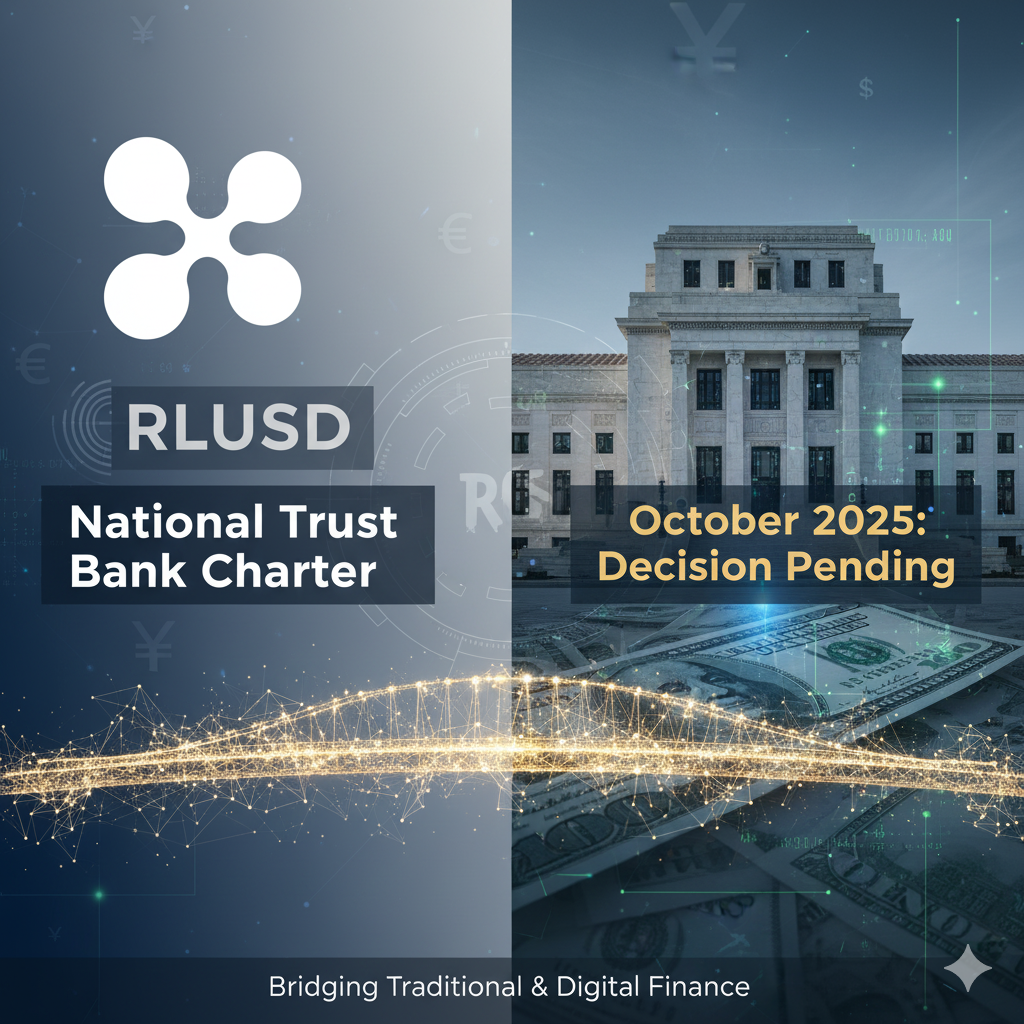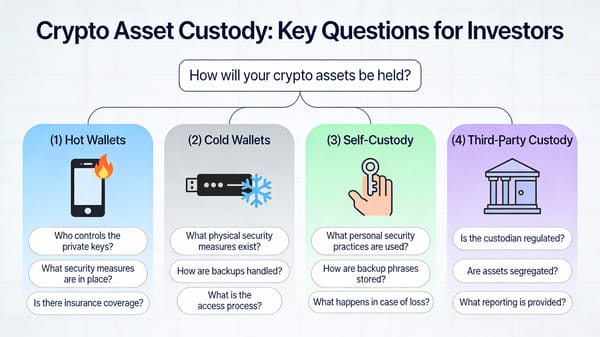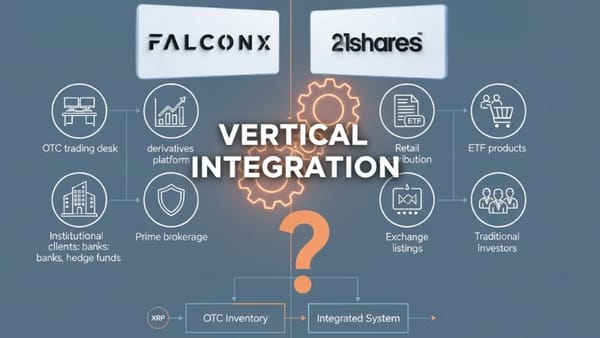Ripple's National Trust Bank Charter: October Decision Could Reshape Crypto Banking
Ripple's national trust bank charter decision arrives in October 2025. The OCC ruling on Ripple National Trust Bank could grant federal banking status for RLUSD stablecoin operations—reshaping crypto's path into traditional finance.

Ripple's National Trust Bank Charter: October Decision Could Reshape Crypto Banking
Ripple Labs has filed an application with the U.S. Office of the Comptroller of the Currency for a national trust bank charter, positioning itself to become a federally regulated banking institution. The application, submitted on June 30, 2025, marks a significant strategic move as the blockchain payments company seeks to expand its institutional footprint and strengthen its RLUSD stablecoin operations.
The decision is expected in late October 2025, coinciding with critical SEC rulings on multiple XRP exchange-traded fund applications. Under OCC rules, decisions on charter applications are typically rendered within 120 days, placing the legal deadline in October 2025. This convergence of regulatory milestones could prove pivotal for both Ripple's corporate trajectory and XRP's market position.

The National Trust Bank Application: What's At Stake
The proposed Ripple National Trust Bank would be headquartered in New York and operate as a wholly owned subsidiary of Ripple Labs. Unlike traditional retail banks, this limited-purpose trust bank would focus on fiduciary services, asset custody, and stablecoin reserve management rather than accepting deposits or making loans.
Granting a national trust bank charter would establish a fiduciary relationship between Ripple and consumers nationwide, allowing Ripple to offer custodial services, hold consumer funds, and manage settlements. The charter would enable Ripple to operate across state lines under unified federal regulation, eliminating the need for multiple state-level money transmission licenses.
The application reveals an experienced leadership structure designed to navigate complex regulatory requirements. Five organizers will serve as the bank's directors: John McDonald (who will serve as President), John Zavaglia (Chief Operating and Trust Officer), Stuart Alderoty (Ripple's Chief Legal Officer), Timothy Keaney (former Vice Chairman of BNY Mellon), and David Puth (former CEO of CLS Group).
Strategic Timing: ABA Membership and Fed Master Account
Ripple's banking ambitions didn't begin with the charter application. Documents show that Ripple became a Platinum Member of the American Bankers Association in June 2024, nearly a year before filing the formal charter application. This membership signaled Ripple's long-term commitment to integrating with traditional banking infrastructure.
Ripple has also applied for a Federal Reserve master account through its subsidiary Standard Custody & Trust Company, which would provide direct access to the Federal Reserve's payment infrastructure. If approved, this would allow Ripple to hold RLUSD stablecoin reserves directly with the central bank, adding an additional layer of security and institutional credibility.
"If approved, we would have both state (via NYDFS) and federal oversight, a new (and unique!) benchmark for trust in the stablecoin market," Ripple CEO Brad Garlinghouse stated when announcing the application.
The RLUSD Connection: Stablecoin Infrastructure Play
The Trust Bank's primary focus will be managing stablecoin reserves for RLUSD and providing related fiduciary services. Ripple issues RLUSD through Standard Custody & Trust Company, a New York limited purpose trust company, but the national charter would significantly expand operational capabilities.
The GENIUS Act for stablecoins, if fully implemented, would mean Ripple could choose for its RLUSD stablecoin to be federally regulated rather than relying solely on state oversight. This dual-layer regulatory framework represents Ripple's bet on comprehensive compliance as a competitive advantage in the evolving stablecoin market.
Notably, the charter application does not mention XRP, which crypto commentators suggest may be a deliberate strategy to separate the banking entity from the digital asset that has faced legal scrutiny. The application focuses exclusively on stablecoin operations and fiduciary services.
Regulatory Opposition and Concerns
The path to approval faces headwinds from consumer advocacy groups and banking trade associations. The Independent Community Bankers of America expressed opposition to Ripple's application, arguing it could undermine financial system stability by allowing a non-traditional institution to offer deposit-like services without adequate regulatory oversight.
The National Community Reinvestment Coalition has strongly opposed the application, raising concerns about Ripple's approach to enforcement, governance, compliance, and consumer protection laws. NCRC specifically highlighted that national trust banks operate outside the Community Reinvestment Act framework and may preempt state consumer protection laws.
If granted, Ripple would operate a national trust bank holding over $60 billion in consumer funds and managing related money transfers, without obligations under the National Bank Charges regulation to consider potential unfair, deceptive or abusive practices when setting fees, according to NCRC's comment letter.
October: A Make-or-Break Month for Ripple and XRP
The banking charter decision arrives during what industry observers are calling a potentially transformational period for Ripple and XRP. The SEC must rule on six spot XRP ETF applications between October 18-25, with issuers including Grayscale, 21Shares, Bitwise, Franklin Templeton, WisdomTree, CoinShares, and Canary Capital all awaiting decisions.
Crypto lawyer Bill Morgan has characterized October as potentially "make-or-break" for Ripple, with both regulatory tracks converging on the same timeframe. The simultaneous decisions create unprecedented uncertainty and opportunity.
XRP has established strong support around $2.80, with the token trading near $3.00 as of early October. Market analysts suggest that positive outcomes on both the banking charter and ETF approvals could catalyze significant price appreciation, though predictions vary widely.
Community Perspectives: Infrastructure vs. Value
The charter application has sparked philosophical debates within the crypto community about Ripple and XRP's respective roles. Prominent crypto commentator Black Swan Capitalist framed the relationship in systemic terms: "Ripple is the trust. XRP is the bank. One builds the rails, the other holds the value. One establishes confidence, the other enables settlement, and solves the problem of value."
This perspective positions the bank charter as part of a broader vision where Ripple provides regulated infrastructure while XRP serves as the settlement layer. "Most still think this is about payments. It's about rebuilding the entire financial system," the analyst argued, suggesting the charter represents foundational positioning rather than incremental expansion.
While such interpretations reflect genuine enthusiasm within the XRP community, the actual charter application outlines more specific, limited objectives. The Ripple National Trust Bank would focus on custody services, fiduciary activities, and stablecoin reserve management—significant capabilities, but distinct from the sweeping transformation some envision. Notably, the application deliberately excludes mention of XRP itself, concentrating exclusively on RLUSD operations.
The divergence between aspirational community narratives and the technical scope of regulatory filings highlights ongoing uncertainty about how blockchain infrastructure will ultimately integrate with traditional finance. The October decision will provide concrete data points about regulators' comfort level with crypto-native firms obtaining federal banking privileges.
Impact on XRP Price and Market Position
Analysts predict that dual approval of the bank charter and XRP ETFs could provide regulatory clarity that redefines XRP's role in global finance by clarifying both regulatory and institutional frameworks. The banking charter would position Ripple among major U.S. financial institutions with comprehensive federal oversight.
If Ripple secures the license, it would become a federally regulated trust bank, enhancing its credibility and allowing RLUSD reserves to be held directly with federal authorities. This institutional legitimacy could accelerate adoption among risk-averse traditional financial institutions.
Vincent Van Code, a prominent crypto commentator, noted the market's apparent disconnect: "It's baffling to me how the whole market is oblivious to these advancements and price of XRP still hovering around $3. Just goes to show how badly informed investors can be."
Market analysts have proposed various price scenarios for XRP depending on the combined outcomes. Bullish scenarios suggest potential moves toward $5-$10 if both approvals materialize, while more conservative forecasts anticipate continued consolidation in the $3-$4 range. Some analysts point to historical patterns following Bitcoin and Ethereum ETF approvals as potential templates for XRP's trajectory.
What This Means for XRP Holders
For XRP holders, the banking charter represents both promise and uncertainty. A favorable decision would validate Ripple's strategy of deep integration with traditional finance and could strengthen institutional confidence in XRP's long-term utility. Rejection, however, might signal regulatory skepticism about crypto-native firms obtaining traditional banking privileges.
The charter approval would provide regulatory legitimacy and trust, expand Ripple's capabilities in financial services like settlement and custody, and reinforce the credibility of Ripple's broader institutional strategy—even if the charter itself doesn't directly involve XRP operations.
Whether the charter approval catalyzes the revaluation bulls anticipate or gets absorbed without major price impact remains to be seen. The next few weeks will reveal whether Ripple's multi-year compliance strategy and institutional positioning pays dividends, or whether regulatory caution prevails. Either outcome will have lasting implications for how blockchain companies integrate with traditional financial infrastructure.
DISCLAIMER: This newsletter is for informational purposes only and does not constitute investment advice, advertising, or a recommendation to buy, sell, or hold any securities. This content is not sponsored by or affiliated with any of the mentioned entities. Investments in cryptocurrencies or other financial assets carry significant risks, including the potential for total loss, extreme volatility, and regulatory uncertainty. Past performance is not indicative of future results. Always consult a qualified financial professional and conduct thorough research before making any investment decisions.
Sources
- OCC Public Filing - Ripple National Trust Bank Charter Application
- NCRC Opposition Letter to Ripple Charter Application
- ICBA Opposition Statement on Ripple's National Trust Bank Application
- CoinDesk: Ripple Applies for Federal Bank Charter, XRP Jumps 3%
- Ledger Insights: How XRP Could Undermine Ripple's Bank Charter Bid
- Fintech Business Weekly: Trust Charter Applications Analysis
- Cointelegraph: Ripple Applies for US Banking License
- Live Bitcoin News: SEC to Decide on Six XRP ETF Applications in October
- The Crypto Basic: October Could Be Massive Month for XRP
- Cointelegraph: Why October Will Be Most Bullish Month for XRP
- CoinCentral: Ripple Faces Critical October Decisions
- AInvest: XRP News - Ripple Faces Two Key October Decisions
- Global Finance Magazine: Ripple Applies for US National Bank Charter
- Mitrade: First Glimpses of Ripple's OCC Banking License Application



